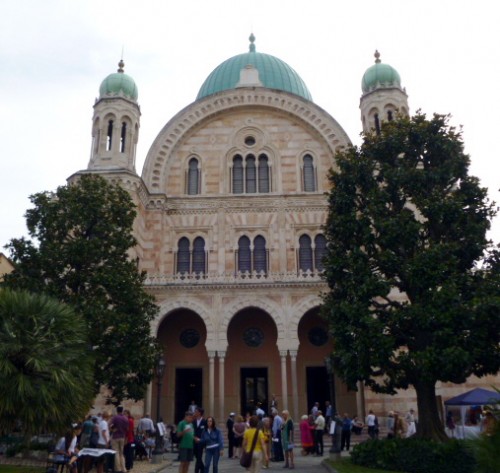Every year in September (this year it was on the 5th) the Synagogue in Florence holds an Open House for the general public. This year it was a chance for everyone, Florentine and tourist, alike, to enjoy the exquisite restoration of one of the most beautiful buildings in the city, while munching on great food, listening to interesting speakers and music, as well as poking into parts of the grand edifice that are not usually open.

The Open House is part of a Europe-wide Day of Hebraic Culture, which included 62 locations across Italy: Giornata Europea della Cultura Ebraica.
In Florence, a bus was provided to take visitors to four other locations, including the Uffizi, the Palazzo Vecchio, and the Pitti Palace, where works by Jewish artists, modern and not, were displayed.
In the garden of the synagogue, there were stands with food and books, a children’s lab and music. Free guided tours of the synagogue, its new expanded museum and of the Jewish cemetery in the Oltrarno were offered.
The Florence Synagogue, one of the most beautiful in Europe, was built between 1874 and 1882. The architects were Mariano Falcini, Professor Vincenzo Micheli, both Catholic, and Marco Treves, who was Jewish. Their design integrated the architectural traditions of the Islamic and Italian worlds.
Layers of travertine and granite alternate in the masonry, creating a striped effect. Old photographs show bold red and beige stripes, but the colors of the stone have faded over time. The overall form of the synagogue is the cruciform plan, similar to the Hagia Sophia in Istanbul. The corner towers are topped with horseshoe-arched towers themselves topped with copper onion domes in the Moorish Revival style. Three arches form the main entrance, above it rise tiers of windows, with their paired arches sharing a single column.
Inside the building every square inch is covered with colored designs incorporating Moorish patterns, but with Jewish symbols and texts.
During World War II, Fascist soldiers used the Synagogue as a vehicle garage. In August 1944 retreating German troops worked with Italian Fascists to blow up the synagogue, but the Italian resistance managed to defuse most of the explosives. Only a limited amount of damage was done. The synagogue was restored after the war. It was restored again after it was damaged by the Flood of 1966.
This past year, the dome was strengthened and resurfaced in copper and a new wing of the museum was added on the top floor. These improvements, coupled with the new lighting, makes a visit a must for those who haven’t been inside in the last few years.
The 2010 Open House drew more than 60,000 in Florence. This is the first year the synagogues of Italy went all out to involve their cities in the exhibition of masterpieces created by Jewish artists.
